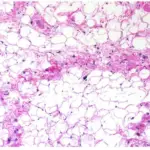Adenomatoid tumors are neoplasm benign of mesothelial sources found more frequently in the male adnexa.
What is the Pathology of Adenomatoid Tumors?
The pathology of adenomatoid tumors is:
-Etiology: The cause of adenomatoid tumors is neoplastic mesothelial cells.
-Genes involved: TRAF7 gene
-Pathogenesis: The sequence of events that lead to adenomatoid tumors not well identified.
-Morphology: The morphology associated with adenomatoid tumors shows trivial, solid, hard, grayish-white, and poorly to well-bounded masses.
-Histology: The histology associated with adenomatoid tumors shows eosinophilic mesothelial cells at the cords and tubules looking like endothelium in origin.
How does Adenomatoid Tumors Present?
Patients with adenomatoid tumors are typically males that present in the age range of 30 to 50 years old. The symptoms, features, and clinical findings associated with adenomatoid tumors include painful palpable masses.
How are Adenomatoid Tumors Diagnosed?
Adenomatoid tumors are diagnosed through serum tumor markers and biopsy. Imaging studies such as ultrasonography may be helpful to visualize the lesion.
How are Adenomatoid Tumors Treated?
Adenomatoid tumors are treated through surgical excision.
What is the Prognosis of Adenomatoid Tumors?
The prognosis of adenomatoid tumors is good. The tumor is not known to recur or show malignant deterioration.



